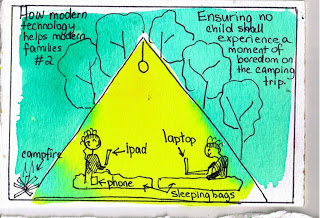Most Americans have gone camping at some point in their lives, while some make it a habit to go at least a couple times a year to “get away”, yet without completely “getting away”. In our modern, 21st century society, how “away” are we when we go camping? The answer to this question depends on geography and how you define what camping is.
My mom and her husband’s idea of camping is driving their vintage Airstream trailer 30 minutes to a local state park and, if necessary, driving back home or to the nearest gas station to run errands or pick up something they forgot, while also making sure to catch any NFL games on their portable television… For others, it means gathering the basic necessities for food, water, shelter and clothing, hiking 10 miles into the wilderness, and returning based on a very carefully designed plan based on when supplies run out.
In his excellent essay for Design Observer on the history of the American campsite, Martin Hogue describes modern camping as allowing humans to be at one with nature, while at the same time relying upon modern conveniences that keep us connected to the real world. It’s an experience characterized by a series of binary opposites: nature and civilization, isolation and connection, self-sufficiency vs. reliance on nature, fixed and temporary structures, spiritual/primitive and modern/technological, and the unfamiliar and the familiar (i.e. nature versus the home).
I really like how he talks about the campsite as a temporary substitute for the home, a place where personal and social activities and interactions take place as if one were at home, just in a different location. The campsite, as it is arranged and set up, becomes the home, and life carries on, with minor adjustments. At the same time, campers must live with the surprises that nature will inevitably provide. We must all deal with bugs and snakes and thieving raccoons no matter how insulated we are from nature while camping.
No longer must we gather food from scratch or clear settings to set up tents with wooden stakes, or cut ourselves off from society completely, unless we want to. If we do, it’s sort of like an homage to the past, to a simpler time with its own challenges. But we also have access to just about any basic modern convenience at the camping site. We can stay connected to the “outside” world through our smart phones. We have so many choices as to how we want to shape our camping excursions, and how comfortable or “authentic” we want to be.
In America, our shared cultural concepts of what camping is today have evolved rapidly, starting in the 1950s with suburban growth and access to vehicles. Hogue observes that technology has changed camping both physically and culturally, especially with the advent of motor vehicles. Tech, along with roads and highways, has expanded access to camping as well as the geography of reach for campers across the country. RVs and Airstreams with built-in bathrooms and televisions and air-conditioners allow campers to bring home with them.
Modern camping allows us to live out our “cultural fantasies” while still remaining connected. Is it still camping if you have access to Wifi, a hair dryer, a phone charger or portable t.v.? I think so. Camping has just changed, that’s all. It looks different to different people.
 Image via Jane Elix
Image via Jane Elix

